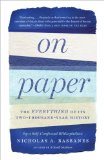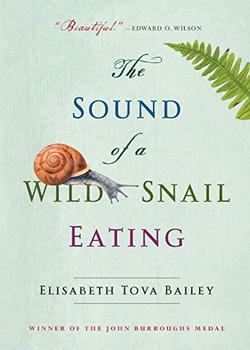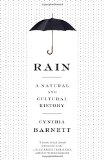Summary | Excerpt | Reviews | Beyond the book | Read-Alikes | Genres & Themes | Author Bio

Critics' Opinion:
Readers' Opinion:
First Published:
Oct 2013, 448 pages
Paperback:
Jul 2014, 448 pages
 Book Reviewed by:
Book Reviewed by:
Bob Sauerbrey
Buy This Book
In the past years, a number of micro-histories have traced the development of human civilization around a common, simple item. For instance, Mark Kurlansky published two books, one tracing the effect of salt on human and animal evolution, and the other examining the role cod has played in history. (See Beyond the Book.) In a like way, Nicholas Basbanes's On Paper traces the development and impact of paper on civilizations.
Our spoken languages came first and later the need, in many places, to represent these languages in visual symbolic form. This permitted record-keeping, as well as the transmission of traditions, values, stories and systems from one generation to later ones. Many writing surfaces were used to preserve these "books," a word etymologically derived from the Germanic name bóc or bók, for the beech tree, whose bark was a convenient medium for the symbols which externalized language. These surfaces were as diverse as the human imagination: skins, walls, woven cloth, metal sheets, pottery shards, and the leaves of likely plants, the most famous of which was papyrus, a plant that grew in abundance on the shores of the Nile. Ultimately, papyrus became the standard in Egypt because it could be finely sliced into thin surfaces, which could then be bound or scrolled into volumes.
However many of these substances were subject to deterioration. In the search to find more substantial material we discovered that flax or cotton could be blended with water and the resulting product, when dried, proved to be a more stable medium for writing. Thus paper was discovered.
Paper originated in China, traditionally dated to 105 A.D. As Basbanes records, "the official historian of the Han Dynasty, Fan Ye, declared that Cai Lu had 'initiated the ideas of making paper from the bark of trees, hemp, old rags, and fishing nets,' and that once perfected the process was 'in use everywhere.'"
Once paper came to Europe, it was possible to print multiple copies of documents because the irregularities of the writing surface were no longer an issue. Johannes Gutenberg linked this uniform paper with the moveable type he developed to create the printing press, which changed history forever. It must be said that moveable type had already been in use in China and Korea, but the simple alphabetic system of European languages made printing a book a lot more feasible than it would have been in China with many thousands of characters.
Basbanes goes on to examine many implications of the introduction of paper into culture, ranging from the obvious, such as making print material available to a larger population, which was becoming increasingly literate, to the more obscure, such as becoming the wrappings for explosive chemicals which could be used as propellants, and even as the covering for the Montgolfier balloons of the 18th century.
Later, the process of making paper from wood pulp was developed, which made books cheaper and made daily newspapers available. Also, as Basbanes reminds us, since wood pulp offered greater production capacity, paper made so many things possible that today we take for granted.
Some predict the demise of paper as digital technologies develop. However, these advances have not lessened our need for paper and, in fact, have highlighted its use. An article in Scientific American, reproduced at Salon, suggests that while electronic devices make many texts immediately available and, in some cases, offer added value (such as interactive maps and graphs), readers find it more difficult to absorb long texts in electronic form than on paper, and many miss the weight, smell and other cues viscerally connected to traditional books.
In his moving and heartfelt conclusion, Basbanes takes us to the ruins of the Twin Towers and the memorials erected around them. What we find and treasure are messages scribbled on scraps of paper that floated down as the Towers collapsed - final opportunities to communicate love, care, and need. Paper is one of a few things that can hold people's hearts in such a way. In On Paper, Nicholas Basbanes has given us more than a treatise on the making of paper but a social history spurred by, and recorded on, thin slices of fiber.
![]() This review was originally published in The BookBrowse Review in January 2014, and has been updated for the
July 2014 edition.
Click here to go to this issue.
This review was originally published in The BookBrowse Review in January 2014, and has been updated for the
July 2014 edition.
Click here to go to this issue.

If you liked On Paper, try these:

The Sound of a Wild Snail Eating
by Elisabeth Tova Bailey
Published 2016
In a work that beautifully demonstrates the rewards of closely observing nature, Elisabeth Bailey shares an inspiring and intimate story of her uncommon encounter with a Neohelix albolabris —a common woodland snail.

by Cynthia Barnett
Published 2016
Rain is elemental, mysterious, precious, destructive. It is the subject of countless poems and paintings; the top of the weather report; the source of the world's water. This is the first book to tell the story of rain.





The House on Biscayne Bay
by Chanel Cleeton
As death stalks a gothic mansion in Miami, the lives of two women intertwine as the past and present collide.

The Flower Sisters
by Michelle Collins Anderson
From the new Fannie Flagg of the Ozarks, a richly-woven story of family, forgiveness, and reinvention.

The Funeral Cryer by Wenyan Lu
Debut novelist Wenyan Lu brings us this witty yet profound story about one woman's midlife reawakening in contemporary rural China.
Your guide toexceptional books
BookBrowse seeks out and recommends the best in contemporary fiction and nonfiction—books that not only engage and entertain but also deepen our understanding of ourselves and the world around us.